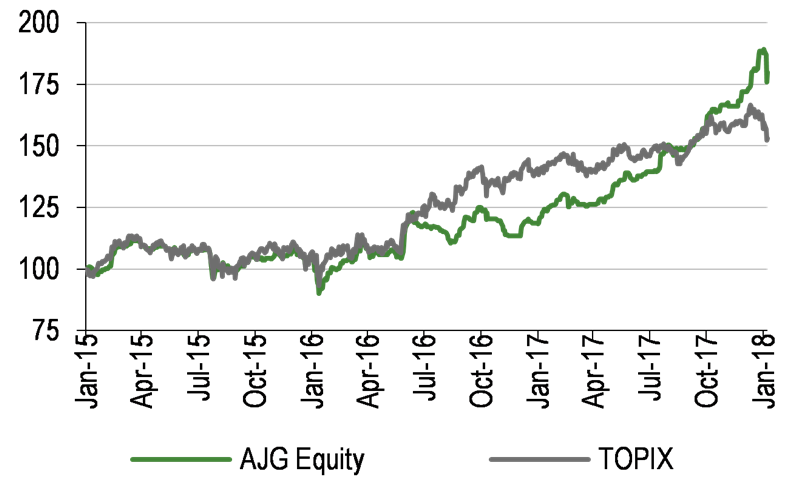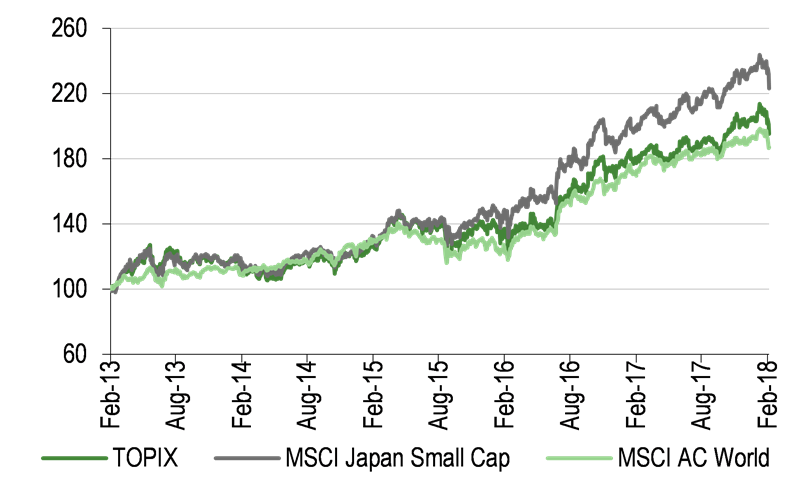Investment process: Bottom-up stock selection
The AIRC team believes that company earnings drive long-term share price performance. It targets undervalued growth companies, seeking well-managed firms, with clear competitive advantages that can generate strong free cash flow. Research is proprietary: stocks are selected on a bottom-up basis, with a mid- to long-term investment horizon. Company meetings are a key element of the investment process, and number c 800 per annum.
AIRC’s investment process can be broken down as follows:
■
Periodic screening – screens on a universe of c 2,000 companies are run on a quarterly basis. Criteria include sales and operating profit growth of 10% or higher, improving operating margins, improving return on equity and valuation multiples such as price-to-book relative to the sector, P/E-to-growth (PEG) and EV/EBITDA.
■
Company visits – these are viewed by AIRC as a critical element to the investment process, to enable an understanding of a company’s business model, strengths/weaknesses and future strategy. Meetings with a company’s competitors and suppliers can reinforce the team’s belief in a firm’s growth potential. These meetings are also able to highlight further companies worthy of fundamental research that are not identified in the screening process.
■
Evaluation – fundamental research assessing long-term sales and earnings growth potential by construction of an earnings growth model.
■
Buy list – typically c 125 companies that may be considered for inclusion in the portfolio. The team has weekly meetings to discuss any updates on companies on the buy list and any new information gleaned from other company meetings. Following discussions, companies are either: added to/kept on the buy list; eliminated from the buy list; or added to/kept on a watch list of c 40 companies with attractive fundamentals, but unappealing valuations.
■
Portfolio construction – AIRC recommends buy list stocks to be included in AJG’s portfolio.
■
Sell discipline – stocks may be sold if there is a downturn in a company’s operating environment, following an earnings disappointment, if there is a perceived unjustified change in the business model or if a portfolio position becomes too large.
AJG’s resulting portfolio is diversified and has a bias towards small- and mid-cap companies. It typically has 50-70 holdings, with the largest positions making up 3% to 4% of the portfolio. If a position increases to 5% of the portfolio, it will usually be reduced. New positions are typically 0.5%, which may be increased to 1% and then 2% if the adviser has a good degree of conviction and there is adequate trading liquidity in the shares. The trust has a high active share, currently 97% (active share is a measure of how a portfolio differs from the benchmark, with 100% representing no commonality and 0% full index replication).
The adviser believes that frequent contact with the managements of investee companies is an effective way of managing portfolio risk. In terms of share liquidity, at end-FY17, based on one third of the last three months’ average daily volume, 95.9% of AJG’s portfolio could be realised within two weeks, with the 4.1% balance realised between two weeks and one month. Portfolio turnover has reduced from an annual rate of 75% now that Setaishi has restructured AJG’s portfolio. The historical range is 30% to 70% pa, depending on market conditions. In 2016 and 2017, the exercise of subscription rights added to the level of portfolio turnover.
Current portfolio positioning
As shown in Exhibit 6, the majority of AJG’s portfolio is held in mid- and small-cap stocks. At the end of January 2018, c 80% of the portfolio was made up of companies with a market cap of less than $5bn. Over the last 12 months, the largest changes in capitalisation exposure were a 13.6pp increase in companies with a market cap between $500m and $2bn and an 11.5pp reduction in companies with a market cap between $2bn and $5bn.
Exhibit 6: Portfolio exposure by market cap (% unless stated)
|
Portfolio end-January 2018 |
Portfolio end-January 2017 |
Change (pp) |
>$10bn |
13.1 |
14.4 |
(1.3) |
$5bn to $10bn |
7.3 |
1.0 |
6.3 |
$2bn to $5bn |
8.9 |
20.4 |
(11.5) |
$500m to $2bn |
39.6 |
26.0 |
13.6 |
<$500m |
31.1 |
38.1 |
(7.1) |
|
100.0 |
100.0 |
|
Source: Atlantis Japan Growth Fund, Edison Investment Research. Note: Rebased for gearing.
Exhibit 7 shows AJG’s sector exposure, which uses Global Industry Classification Standard (GICS) rather than TOPIX classifications. Over the 12 months to end-January 2018, the largest increase in exposure was industrials (+15.3pp), while the largest decreases were financials (-11.1pp) and materials (-4.9pp). Versus the benchmark, the major overweight exposures are industrials and technology (both c 2.0x weighted), with underweight positions in telecoms, financials, materials and consumer discretionary. Illustrating the unconstrained nature of AJG’s investment approach, the trust has no exposure in the consumer staples, energy and utility sectors.
While the adviser makes stock decisions on a bottom-up basis, with no specific sector allocations, there are several key long-term investment themes within AJG’s portfolio. These include:
■
Factory automation – Japan holds a leading global position in the provision of robots and material handling systems to manufacturers and logistics operators. Examples in AJG’s portfolio include top 10 position Daifuku (material handling) and Keyence (sensors).
■
Healthcare – due to the aging population in Japan, there is increasing demand for healthcare, both in terms of products and services. AJG’s holdings in the sector include top 10 position Asahi Intecc (medical devices), Cyberdyne (robotics), PeptiDream (drug discovery) and Solasto (healthcare services).
■
Outsourcing – due to tight labour conditions, companies are increasingly outsourcing non-core operations. One of AJG’s holdings is Benefit One, which administers welfare and employee benefit programmes for both public and private companies.
■
Semiconductor equipment – ongoing technological developments will support continued demand for semiconductor equipment. One of AJG’s positions is Tokyo Electron, which is a supplier of equipment to fabricate integrated circuits, flat panel displays, and photovoltaic cells.
Exhibit 7: Portfolio sector exposure vs benchmark (% unless stated)
|
Portfolio end-
January 2018 |
Portfolio end-
January 2017 |
Change
(pp) |
Index
weight |
Active weight
vs index (pp) |
Trust weight/
index weight (x) |
Industrials |
47.4 |
32.1 |
15.3 |
23.0 |
24.4 |
2.1 |
Information technology |
23.5 |
23.8 |
(0.3) |
12.6 |
10.9 |
1.9 |
Consumer discretionary |
11.2 |
15.2 |
(3.9) |
19.6 |
(8.3) |
0.6 |
Healthcare |
6.4 |
4.9 |
1.6 |
6.6 |
(0.2) |
1.0 |
Real estate |
5.7 |
0.0 |
5.7 |
3.1 |
2.5 |
1.8 |
Materials |
3.9 |
8.8 |
(4.9) |
7.4 |
(3.5) |
0.5 |
Financials |
1.2 |
12.4 |
(11.1) |
12.2 |
(10.9) |
0.1 |
Telecommunications |
0.6 |
0.0 |
0.6 |
4.6 |
(4.0) |
0.1 |
Energy |
0.0 |
0.0 |
0.0 |
1.1 |
(1.1) |
N/A |
Utilities |
0.0 |
0.0 |
0.0 |
1.5 |
(1.5) |
N/A |
Consumer staples |
0.0 |
3.0 |
(3.0) |
8.4 |
(8.4) |
N/A |
|
100.0 |
100.0 |
|
100.0 |
|
|
Source: Atlantis Japan Growth Fund, Edison Investment Research, Bloomberg. Note: Rebased for gearing.
Setaishi highlights some of the positions in AJG’s portfolio as good examples of companies which meet the investment criteria: Funai Soken, Okada Aiyon and top 10 position Yamashin Filter. Funai Soken is a relatively new addition; it had been held in the past, but was sold when its valuation became stretched. It is a management consulting company providing services to c 5,000 small- and mid-sized companies across a range of sectors, including real estate and pharmacy chains. It has a high level of repeat business, with c 80% of customers renewing their contracts. The company has a team-based approach, which promotes low staff turnover and a high level of customer service. Funai Soken is able to supplement its organic growth with selected mergers and acquisitions, which is an increasing feature within the Japanese economy. The company has operating margins of c 25%, a return on equity of c 15% and earnings are growing at a double-digit annual rate.
Okada Aiyon manufactures equipment for the demolition of buildings, such as breakers, crushers, cutters and drills. It has a c 40% market share in Japan, which the company is aiming to grow to 50%. It has much lower presence in countries overseas, which offers the potential for growth. Demand is particularly strong for more environmentally friendly products, which are quieter and cleaner. There is potential for the company to expand its operating margins from the current level of c 10%, it has a return on equity of c 10% and accelerating double-digit annual earnings growth.
Yamashin Filter produces hydraulic filters, primarily for construction machines. The company has high market shares of more than 70% in Japan and c 50% worldwide. Yamashin Filter is expanding its product range to other sectors such as agriculture, food processing and industrial machines. About half of its business is replacement parts, which are higher-margin than filters for original equipment. The company has operating margins of c 10%, a return on equity of c 10% and annual earnings growth of more than 15%.
In recent months, new investments in the portfolio span a range of industries. These include systems integration specialist BayCurrent Consulting, which is a recovery situation. Following the company’s public offering in September 2016, it missed its earnings forecast, leading to a decline in its share price. The company now has a new management team and business is improving.






























